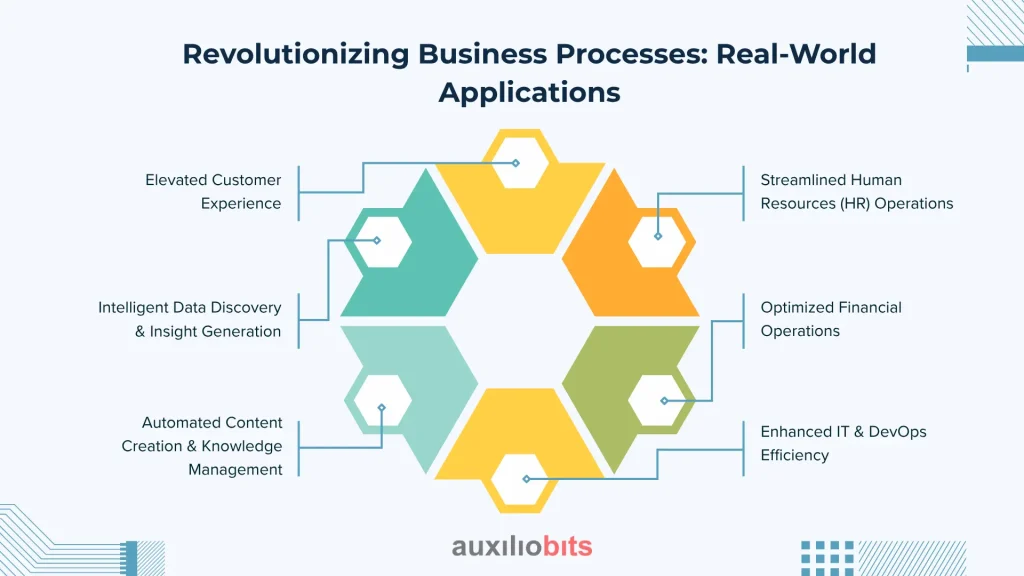
Key Takeaways
- LangChain empowers automation with context, not just instructions.
Gone are the days of rule-based rigidity—LangChain enables agents that understand nuance, remember past interactions, and act with autonomy. - Chains, agents, tools, and memory form the pillars of LangChain’s architecture.
Each component plays a role in building workflows that are modular, intelligent, and adaptable to real-world messiness. - Retrieval Augmented Generation (RAG) is a game-changer for factual accuracy.
By retrieving relevant documents and knowledge in real time, LangChain agents reduce hallucinations and deliver grounded, reliable responses. - The use cases span every department—from HR to finance to IT.
Whether it’s summarizing reports, debugging code, or assisting new hires, LangChain-driven agents are proving useful across business functions. - This isn’t about replacing humans—it’s about liberating them.
- LangChain helps eliminate the tedious stuff so your people can focus on what truly matters: creativity, strategy, and meaningful work.
Let’s face it—business automation has come a long way from the days of clunky macros and rule-based bots that could barely respond to anything more nuanced than a pre-scripted dropdown selection. We’ve all been there, watching an RPA bot crash mid-process because someone typed “NYC” instead of “New York.” Annoying? Absolutely. Avoidable? Not with the old playbook.
But then something changed. Not all at once, mind you. It started with whispers—words like “LLMs,” “autonomous agents,” and a curious little thing called LangChain. And that’s when it clicked: maybe the next generation of process automation didn’t have to be so rigid, so… robotic.
Also read: EMR Integration Using LangChain and OpenAI for Smart Data Entry
LangChain: The Foundational Architecture for Intelligent Agents
LangChain stands out as a pioneering open-source framework specifically engineered to streamline and simplify the development of sophisticated applications powered by large language models (LLMs). It offers a comprehensive suite of modular building blocks and powerful abstractions essential for constructing robust, context-aware agents that can effortlessly interact with diverse data sources, reason intelligently, and execute complex workflows.
Let’s delve deeper into how LangChain empowers the creation of these cutting-edge intelligent business process agents:
1. Chains: Orchestrating Complex Workflows:
At its very core, LangChain enables developers to meticulously chain together various distinct components. Picture this as a highly customizable workflow where the output from one meticulously executed step seamlessly becomes the input for the next. This modularity allows for the precise orchestration of intricate sequences, ranging from intelligent data retrieval and advanced LLM interaction to sophisticated output formatting and dynamic tool utilization.
2. LLMs (Large Language Models): The Brains of the Operation:
LangChain provides a unified and intuitive interface to seamlessly interact with a wide array of powerful LLMs (such as OpenAI’s GPT models, Anthropic’s Claude, and open-source alternatives). This flexibility allows organizations to strategically choose the most suitable and cost-effective model for their specific task, optimizing both performance and resource utilization.
3. Prompt Templates: Guiding the LLM with Precision:
Crafting effective and unambiguous prompts is an art form crucial for effectively guiding LLMs to produce desired outputs. LangChain’s robust prompt templating system enables the definition of structured, reusable prompts with dynamic variables. This ensures consistency, simplifies the integration of relevant context, and allows for easy experimentation and refinement of agent behavior.
4. Retrieval Augmented Generation (RAG): Elevating Accuracy and Reducing Hallucinations:
This is arguably one of LangChain’s most transformative features for achieving true context-awareness. LangChain brilliantly facilitates Retrieval Augmented Generation (RAG) workflows. In a RAG setup, agents can intelligently retrieve highly relevant information from vast external knowledge bases—think your company’s proprietary internal documents, comprehensive product manuals, up-to-the-minute customer data, or even publicly available research papers—and then seamlessly incorporate this retrieved context to inform and enrich their responses. This powerful mechanism dramatically mitigates the risk of “hallucinations” (where LLMs generate factually incorrect information) and significantly boosts the factual accuracy and relevance of the agent’s output.
5. Memory: Ensuring Coherence Across Interactions:
For agents to maintain a sense of continuity and provide a truly fluid user experience, persistent context across multiple interactions is vital. LangChain offers a variety of sophisticated memory systems, ranging from simple conversational buffers to more advanced summary memory. This allows agents to “remember” previous turns in a conversation, individual user preferences, and the ongoing state of a task, making interactions feel far more natural, intelligent, and effective over time.
6. Agents: Autonomous Reasoning and Action:
LangChain’s “agent” abstraction is where the true power of intelligent automation is unleashed. Agents are essentially intelligent programs that can reason about a complex problem, intelligently break it down into smaller, manageable sub-tasks, and autonomously decide which specific tools or actions to take to achieve a defined goal. This iterative decision-making process allows for genuinely autonomous, adaptable, and highly intelligent behavior, moving beyond simple predefined rules.
7. Tools: Extending Agent Capabilities to the Real World:
Agents are not isolated. They can be dynamically equipped with a rich arsenal of “tools” to interact with the external world and execute real-world actions. This comprehensive toolkit can include APIs to securely access and update databases, modules to execute custom code, functions to send personalized emails or notifications, integrations with CRMs or ERP systems, or even interfaces to interact with other specialized software applications. This extensibility dramatically expands the agent’s capabilities far beyond mere text generation, transforming them into proactive digital workers.
Revolutionizing Business Processes: Real-World Applications
The transformative potential of LangChain-powered context-aware agents across various business functions is truly immense and continues to grow:

Elevated Customer Experience (CX):
Imagine agents that can access a customer’s entire interaction history, detailed product specifications, warranty information, and even relevant troubleshooting guides to provide highly personalized, accurate, and empathetic support. This reduces resolution times, improves customer satisfaction, and frees human agents to focus on complex, high-value cases.
Intelligent Data Discovery & Insight Generation:
Automate the laborious and often mind-numbing process of sifting through vast, unstructured datasets for legal teams, financial analysts, market researchers, or even medical professionals. Agents can summarize key insights, identify critical trends, flag anomalies, and present actionable intelligence, dramatically accelerating decision-making.
Automated Content Creation & Knowledge Management:
Rapidly generate first drafts of internal reports, external marketing copy, legal disclaimers, or personalized email campaigns. Furthermore, agents can efficiently summarize lengthy documents, extract key information, and organize knowledge bases, significantly boosting productivity for marketing, legal, and executive teams.
Streamlined Human Resources (HR) Operations:
Automate responses to a wide range of common employee queries (e.g., benefits information, leave policies), personalize the onboarding experience for new hires by providing tailored information, and efficiently manage routine HR administrative tasks, allowing HR professionals to focus on strategic initiatives.
Optimized Financial Operations:
Empower agents to assist in meticulous expense tracking, generate sophisticated cash flow forecasts, analyze intricate financial reports, and even identify potential investment opportunities by processing and synthesizing vast amounts of financial data from various sources.
Enhanced IT & DevOps Efficiency:
Agents can become invaluable partners for development and IT operations teams. They can assist in debugging complex code, generate boilerplate code for new projects, automate routine system monitoring tasks, or even contribute to aspects of continuous integration/continuous deployment (CI/CD) pipelines, improving developer productivity and system reliability.
The Inevitable Future of Business Automation
By strategically embracing and implementing powerful frameworks like LangChain, businesses can confidently move beyond simplistic, rigid automation to build truly intelligent, adaptable, and profoundly context-aware agents. It’s crucial to understand that these agents are not designed to outright replace human intelligence. Instead, they are powerful tools designed to augment it, freeing up invaluable human capital to focus on more creative problem-solving, strategic planning, complex relationship building, and innovative thinking. The inevitable outcome is a more streamlined, significantly more efficient, highly responsive, and ultimately, more agile and successful business that is well-equipped to navigate the complexities of the modern world.








